This was a dream come true. Since I was a little girl I have admired & loved this cake. It is made for very special occasions like weddings, christenings, special birthdays or anniversaries. I found an entry for “coque” in an old Gascon dictionary that says “qu’èm invitats a la còca” meaning “we are invited to the christening.”
It takes hours to complete this cake and needless to say it is a very special present to be given one. When I spoke about Pierre’s birthday menu to my friend & neighbor Roland Jamme I couldn’t believe he offered to make one with his wife Simone. Not only were they going to make it, but I could be there the whole time! This incredible ancient cake takes over 5 hours to make and requires the constant participation of 2 people who will endure intense heat. As you will see below, someone has to sit in front of the fire at all times.
After consulting with Simone, Roland they set up the cake making date for Saturday July 9 at 8:30 am., i.e. 6 days before the party, which would be perfect as the cake needs to age before being served.
I was instructed to show up in Garin —where Simone’s family home is— on time and with all the ingredients .
Thus I showed up very excited and armed with 72 eggs, 3 kgs of flour, 3 kgs of sugar, 3kgs of butter, 15 packed of vanilla flavored sugar, 1/2 litre of rum Negrita & a roll of parchment paper. I was finally going to see the gâteau à la broche made from scratch like it as been done for hundreds of years! So, voilà le photo-reportage of the making –and do not miss the short video. I want to thank Simone & Roland from the bottom of my heart for this incredible day.
All the ingredients are placed on the table in order not to forget anything.
Then all the 72 super fresh eggs are carefully separated.
I was entrusted with slowly melting the butter in a pan while Roland started whipping the egg whites.
Simone hand mixes all the ingredients expertly; the rum is the last one to go in.
Roland had started the fire before I arrived. Once the batter is done, the ancient wooden mold is warmed up then wrapped in parchment paper.
The wrapped mold is warmed up again and lathered with butter. Now the cooking part can begin. Simone takes her position in front of the hearth and starts pouring the batter while Roland turns the handle. Simone & Roland have mentioned several time that the starting of the cake is a crucial moment in order to make it sturdy. The main fear is always to break the cake and this fear is only lifted once it has been delivered to the party place!
Slowly but surely the pouring & cooking continue. Closely supervised, I anxiously got to relieve Simone at pouring a few times and Roland at turning. As the cake becomes heavier the turning/cooking gets trickier. The conversations are continuously interrupted by comments or commands like: “Il faut mettre – put some on,” ” tourne plus vite – turn faster,” “attention le pied – watch the bottom,” “attend! les piques brillent encore – Wait, the peaks are still shining.”
Roland keeps feeding the fire with long logs that he and his nephew Fabrice have cut for the occasion. Each log is carefully picked as the fire needs to be highly controlled. Logs & embers are moved according to where most heat is needed. Here we can see the cake shaping up. The “peaks” are starting to form. One of the conversation around the fire was about the length of the peaks, the pride of the cake makers, though Simone points out that she favors the taste over the shape and I agree.
As the batter in the basin diminishes slowly, Simone is wiping the sweat off her face more often. I try to relieve her as much as I can, but her expert hand is needed to “mettre” properly as it is getting more difficult; due to peak formation the batter sticks less and less so the spooning over has to be more frequent and the batter dripping in the pan needs to be quickly collected —that is before it cooks– and spooned back on too the cake (see video below).
Here we go! many hours later finally the last spoon of batter! The cake is perfect, just a little more cooking to give it the final golden look.
The cake is brought inside to cool off while resting between two chairs. After lunch Roland, with the help of Simone’s brother Jean-Claude, the mold is removed with a mallet! That part is very scary and you can sense the how everyone is tense in order to execute the appropriate move in order not to break the cake.
The cake was delivered by Roland & Simone on the morning of the party on July 14. We served it for dessert accompanied by crème paysanne —aka crème anglaise— that my mother, Marie-Jeanne Jamme & Robi Castbrunet made. What a gift! I am so thankful to Roland and Simone for their generosity, time, expertise & hospitality at her family home. Watch the video and stay tune for the rest of the menu!
For your information a very similar cake, called Šakotis, is make in Lithuania, another close cousin is the German Baumkuchen.
Photos Credit: Nicole Peyrafitte & Roland Jamme
Video: Nicole Peyrafitte
Flower arrangement on the cake: Sylvia Gorelick

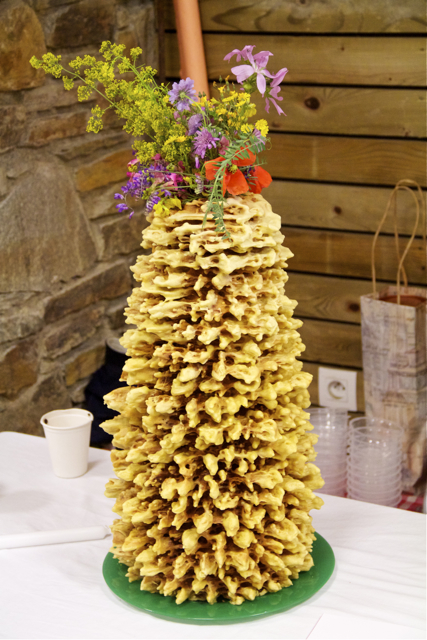
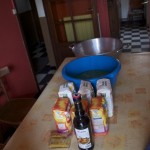
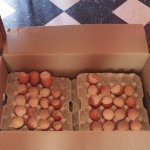
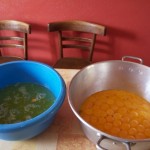
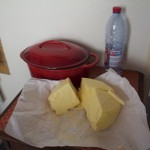
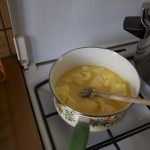
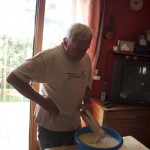
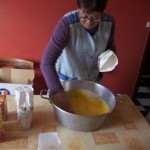
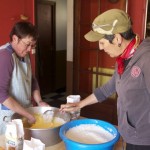
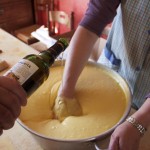
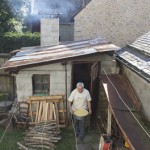
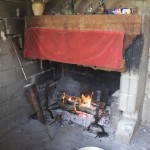
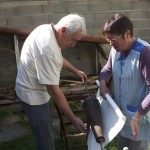
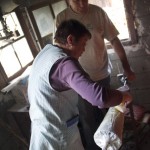 .
.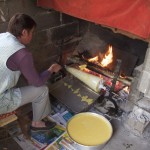
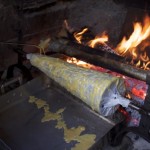
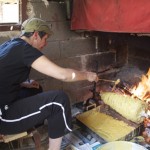
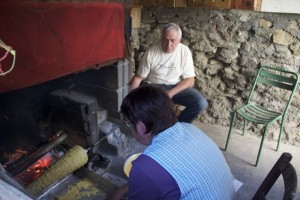

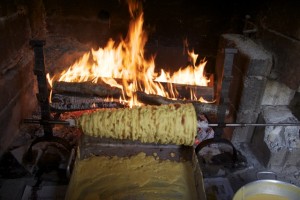
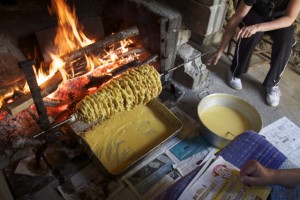
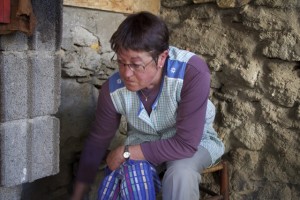
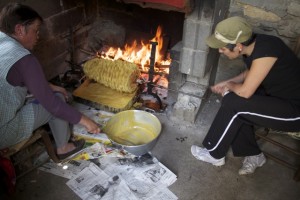
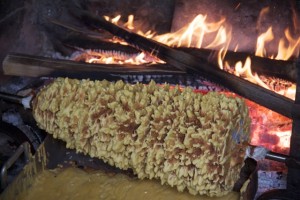
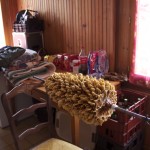
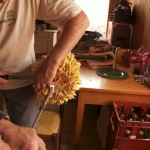
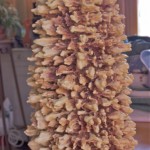

It’s been some time since I heard a French chicken. As to the cake, yet another reason for me to regret missing the party. My mouth watered just reading and watching. You have wonderful friends too. By the way, was that chicken responsible for all or any of the 72 eggs?
A staggering effort and work of culinary art! What volumes it speaks of a culture that would put the time and effort into such a creation! And of your friends, who would bring that effort into the short-attention-span 21st century. I am in awe.
We watched agog! Huddling in the airconditioned study. Seems a bit pallid to say “happy birthday, Pierre” but so it goes. Cheers — Martha & Baz
Nicole:
What an amazing photolog and video. I, too, am impressed that in our speedy culture, there is still a love for the slowness and intimacy of a thing made by hand and with much love.
Always a treat to visit your blog,
Megan
72 eggs! Oh lala!!